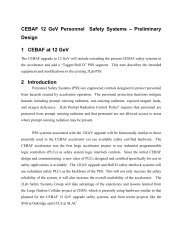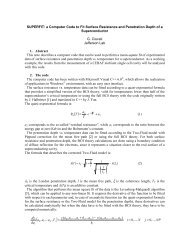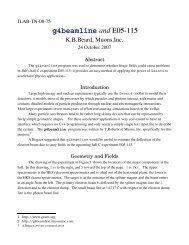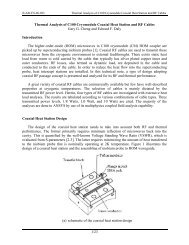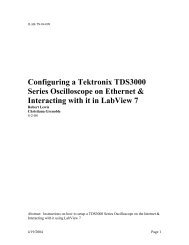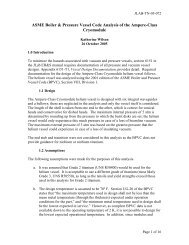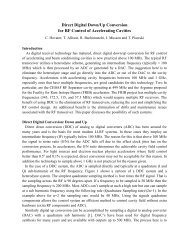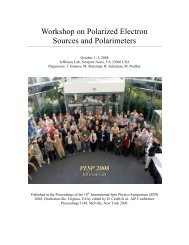JLab-TN-06-046 Safety and Health Analysis of the ... - Jefferson Lab
JLab-TN-06-046 Safety and Health Analysis of the ... - Jefferson Lab
JLab-TN-06-046 Safety and Health Analysis of the ... - Jefferson Lab
- No tags were found...
Create successful ePaper yourself
Turn your PDF publications into a flip-book with our unique Google optimized e-Paper software.
<strong>J<strong>Lab</strong></strong>-<strong>TN</strong>-<strong>06</strong>-<strong>046</strong><strong>Safety</strong> <strong>and</strong> <strong>Health</strong> <strong>Analysis</strong> <strong>of</strong> <strong>the</strong> Arc Magnet Plan for <strong>the</strong> 12 GeV UpgradeProjectP. Hunt <strong>and</strong> R. MayI. Description <strong>of</strong> Baseline Approach ConditionsThe 12 GeV CEBAF Upgrade project includes modifications to <strong>the</strong> magnets in <strong>the</strong>recirculation arcs <strong>and</strong> <strong>the</strong>ir power supplies to keep <strong>the</strong> higher energy beam confined to <strong>the</strong>existing beam path. In addition, a tenth arc-beam line will provide an extra pass through <strong>the</strong>North Linac.With respect to <strong>the</strong> recirculation arc magnets, <strong>the</strong> Baseline Approach includes extensive reuse<strong>of</strong> existing dipoles. These modified magnets will be driven with approximately double <strong>the</strong>current at which <strong>the</strong>y are presently used. No additional cooling is planned for <strong>the</strong> magnets;this will result in <strong>the</strong> magnets being significantly hotter than at present. The approximatepredicted conditions were as follows:Table 1, Initial Predicted ConditionsAmbient Air TempMagnet Surface Temp10 min 1 hour10 min1 hour afterDuring ops after after During ops afteraccessaccess accessaccess135 F (57 C) 135 F 135 F 135 F (57 C) 135 F 130 F (54 C)The ESH&Q staff evaluated <strong>the</strong> hazards associated with elevated magnet temperature.• No specific guidance exists in <strong>the</strong> existing <strong>J<strong>Lab</strong></strong> ESH&Q Manual on working on oraround hot surfaces.• The ESH&Q Manual Chapter 6670, Thermal Stress, gives exposure limits for workunder non-solar, heat stress conditions. These limits are based on ACGIH ThresholdLimit Values that are derived from wet bulb globe temperature (heat index)measurements. Heat index measurement takes into consideration air temperature,humidity, air movement, radiant heat from hot objects, <strong>and</strong> body cooling due to sweatevaporation. A heat index <strong>of</strong> 135 F, which can be reached in ambient temperatures <strong>of</strong>about 105 F - 130 F depending on humidity <strong>and</strong> o<strong>the</strong>r conditions, constitutes apotentially dangerous work condition.II. Initial response to elevated air temperaturesAs a result <strong>of</strong> potentially dangerous heat stress conditions, an air conditioning system with100-ton capacity was designed to cool <strong>the</strong> air in <strong>the</strong> vicinity <strong>of</strong> <strong>the</strong> recirculation arc magnets.An analysis <strong>of</strong> <strong>the</strong> added cooling results in <strong>the</strong> following predicted conditions:
Table 2, Predicted Conditions With Air CoolingAmbient Air TempMagnet Surface Temp1 hour10 min 1 hour10 min afterDuringDuring opsafterafter afteraccessopsaccessaccess access105 F (54 C) 95 F (35 C) 95 F 135 F 135 F 130 FAs can be seen, <strong>the</strong> added cooling produces substantially cooler ambient air temperatureshortly after beam shutdown. The air conditioning system was <strong>the</strong>n added to <strong>the</strong> 12 GeVUpgrade Project scope <strong>and</strong> incorporated into <strong>the</strong> Baseline Approach.For <strong>the</strong> analysis presented in <strong>the</strong> remainder <strong>of</strong> this document, <strong>the</strong> conditions a worker mightencounter with <strong>the</strong> Baseline Approach are those represented in Table 2 above.III. Hazard criteria for exposure to hot surfacesAs mentioned above, <strong>the</strong> ESH&Q Manual Chapter 6670, Thermal Stress, gives exposurelimits for work under non-solar, heat stress conditions. In addition, OSHA provides guidancein Publication 3154 for working elevated air temperature. Because <strong>the</strong> manual contains labrequirements on heat stress consistent with OSHA guidance, no additional information on thishazard (beyond that associated with actual workplace measurements) is discussed in thisdocument. There are, however, no federal statues that apply directly to workplace hazardsassociated with hot surfaces.OSHA provides general requirements in 29 CFR 1910 Section 5(a)(1), General Duty Clause,which states that an employer must “furnish to each <strong>of</strong> his employees employment <strong>and</strong> a place<strong>of</strong> employment which are free from recognized hazards…”An August, 19, 1998 OSHA Interpretation indicates that, “Workers must be protected fromhazards <strong>of</strong> heated (hot) surfaces.”A. Information exists on health effects from contact exposure to industrial surfaces suchas those furnished by Eastman Kodak in Table 3 below.Table 3, Industrial Surface Temperature EffectsMaterialContact ThresholdsPain, 1 sec Burn, 1 sec Burn 4 secMetals 113F (45C) 149F (65C) 140F (60C)Glass 131F 185FWood 167F 239-284F*B. State law exists on <strong>the</strong> subject with respect to certain conditions. For example, <strong>the</strong>California Code <strong>of</strong> Regulations Subchapter 7, Group 2, Article 7 says, “Pipes or o<strong>the</strong>rexposed surfaces having external surface temperature sufficient to burn human skin onmomentary contact <strong>and</strong> located within 7 feet measured vertically from <strong>the</strong> floor orworking level or within 15 inches measured horizontally from stairways, ramps, orfixed ladders shall be covered with a <strong>the</strong>rmal insulating material or o<strong>the</strong>rwise guarded
against contact.” This reference is important in that it identifies administrative controlrequirements <strong>and</strong> barriers to mitigate burn hazards.C. The American Society for Testing Materials (ASTM), which produces nationalconsensus st<strong>and</strong>ard, published C 1055-92, "St<strong>and</strong>ard Guide for Heated SystemConditions that Produce Contact Burn Injuries". This guide provides a means bywhich an engineer can analyze conditions <strong>and</strong> determine <strong>the</strong> acceptable surfacetemperature <strong>of</strong> an existing system where skin contact with a heated surface can occur.Toge<strong>the</strong>r <strong>the</strong> above references provide a method to evaluate hazards from hot surfaces <strong>and</strong>provide guidance on what constitutes acceptable hazard mitigation. The resultant protocol isoutlined in <strong>the</strong> following section <strong>of</strong> this document.IV. Hazard <strong>Analysis</strong> BasisASTM C 1055-92 defines <strong>the</strong> following analysis process:A. Establish an acceptable injury level: In our case, avoidance <strong>of</strong> first degree burns(reversible epidermal injury)B. Establish contact exposure time: For industrial processes, 5 seconds.C. Determine <strong>the</strong> maximum operating temperature (consistent with C 680 method)D. Use <strong>the</strong> contact time <strong>and</strong> maximum operating temperature with Figure 1 belowIf <strong>the</strong> maximum operating temperature falls below <strong>the</strong> selected injury threshold in Fig. 1, <strong>the</strong>nno fur<strong>the</strong>r analysis is required. If <strong>the</strong> maximum operating temperature is above <strong>the</strong> injurythreshold, fur<strong>the</strong>r analysis is required in <strong>the</strong> form <strong>of</strong> additional calculations or directmeasurements.Access to <strong>the</strong> accelerator tunnel is controlled by <strong>the</strong> Operations Staff. Personnel cannot enter<strong>the</strong> tunnel without <strong>the</strong> Operations crew <strong>and</strong> <strong>the</strong> individuals who intend to enter <strong>the</strong> tunnel witha specified set <strong>of</strong> steps that are monitored <strong>and</strong> controlled. A minimum time an individual canenter <strong>the</strong> tunnel after <strong>the</strong> magnets are turned <strong>of</strong>f is cannot occur until several minutes after deenergizing<strong>the</strong> magnets. This can be set at 10 minutes.
Using <strong>the</strong> data provided by <strong>the</strong> 12 GeV engineers, <strong>the</strong> maximum magnet surface temperaturefor an arc magnet is 135 F 10 minutes after <strong>the</strong>y are de-energized. Using 5 seconds as amaximum contact time for inadvertent contact, <strong>the</strong> associated point on Fig. 1 fallsapproximately on or about <strong>the</strong> Threshold B curve. Based on this information, no additionalanalysis is planned <strong>and</strong> a redesign <strong>of</strong> <strong>the</strong> arc magnet cooling is not warranted. However,heated surfaces <strong>and</strong> elevated air temperature remain workplace hazards <strong>and</strong> a strategy isneeded to address <strong>the</strong>m.V. Strategy <strong>and</strong> Hazard MitigationsThere are generally two conditions under which accelerator tunnel access is made:A. Long-delay access with pre-scheduled maintenance workB. Unscheduled access with short delay between de-energizing <strong>the</strong> magnets <strong>and</strong>personnel in <strong>the</strong> tunnelDepending on <strong>the</strong> quantity <strong>of</strong> work <strong>and</strong> <strong>the</strong> long-term accelerator operations schedule, ascheduled access requires pre-work planning including an associated task hazard analysis. Inaddition, a scheduled access is <strong>of</strong>ten preceded by a several shifts (to several days) to allow forradioactive decay. According to information from <strong>the</strong> Engineering Department, within about16 hours, magnet surface temperature will return to ambient temperature (inlet magnet watercooling temperature) in <strong>the</strong> region <strong>of</strong> <strong>the</strong> recirculation arcs: about 95 F. Task hazard analysescan be augmented to identify any new conditions but, for <strong>the</strong> most part, heat stress <strong>and</strong>(<strong>the</strong>rmally) hot magnet surfaces will require no special precautions over those normallyassociated with accelerator tunnel access. Therefore, <strong>the</strong> remainder <strong>of</strong> this section is focusedon unscheduled (<strong>and</strong> thus short delay after magnet de-energizing) accelerator tunnel access in<strong>the</strong> vicinity <strong>of</strong> <strong>the</strong> recirculation arcs <strong>and</strong> <strong>the</strong> associated hazards: contact burn <strong>and</strong> heat stress.These conditions discussed above are represented in Table 4, below:Table 4, Hazard Mitigations(for various work situations <strong>and</strong> exposure types)Delay priorto accessExposuretypeInadvertentRequired bytasking(beyond thatneeded forInadvertent)Short delay• OSP• Training• Posted “safe zone”• Flashing signs• OSP• Training• Guarding/shielding• Measure heatindex• Spot cooling• PPE• Work/rest regimenLongdelayNA(Nohazard)NA(Nohazard)
Potential frequency <strong>of</strong> exposure:An analysis <strong>of</strong> accelerator operations logs for unscheduled accelerator tunnel access produced<strong>the</strong> following information:There have been 18 recent unscheduled access events in approximately 18 months thatresulted in 2 events that brought workers to <strong>the</strong> vicinity <strong>of</strong> <strong>the</strong> recirculation arc magnets.At approximately 1 event per year, exposure to this hazard is infrequent.In addition, <strong>the</strong> accelerator has a Personnel <strong>Safety</strong> System (PSS) designed to precludetunnel access during operations. The PSS also limits personnel access during o<strong>the</strong>r nonoperationalconditions such as those associated with unscheduled access events. Theopportunity for worker exposure <strong>and</strong> <strong>the</strong> exposed worker population is small.This evaluation notwithst<strong>and</strong>ing, more frequent accesses will no doubt be needed during 12GeV commissioning. It is still not unreasonable to assume that <strong>the</strong>re is infrequent need foraccess to <strong>the</strong> vicinity <strong>of</strong> <strong>the</strong> recirculation arc magnets <strong>and</strong> inadvertent exposure to <strong>the</strong> hazardsin <strong>the</strong>se areas is inconsequential.Even though inadvertent exposure to contact burn <strong>and</strong> heat stress is minimal, work may berequired that results in worker exposure to <strong>the</strong>se hazards for short durations. Contact burnavoidance will be accomplished several ways:a) Thermometry installed on reference magnet surfaces will illuminate signs at <strong>the</strong>entrances to recirculation arcs <strong>and</strong> warn <strong>of</strong> surface temperatures >135 Fb) Signs will be posted on magnet metal surfaces that are likely to exceed 113 F <strong>and</strong>131 F for o<strong>the</strong>r non-metal magnet related materials if applicablec) Floor markings that will be used to designate “Keep Out” zones when <strong>the</strong> warningsigns are illuminatedd) Data from reference magnet <strong>the</strong>rmometry will be available in <strong>the</strong> Machine ControlRoom for review by staff prior to accesse) IR scans be used to determine magnet surface temperature in <strong>the</strong> immediatevicinity <strong>of</strong> work. PPE <strong>and</strong> guarding requirements will be determined at specificwork locationsHeat stress exposure controls will be accomplished several ways depending on <strong>the</strong> specificwork situations:a) Monitoring <strong>of</strong> heat stress conditions will be accomplished by permanentinstallation <strong>of</strong> WBGT <strong>the</strong>rmometry will be installed at reference locations in <strong>the</strong>recirculation arcs. Illuminated warning signs at <strong>the</strong> entrances to <strong>the</strong> recirculationarcs will be powered if <strong>the</strong> heat stress index reaches a predetermined value; datawill be available in <strong>the</strong> Machine Control Roomb) Spot cooling will be used to moderate air temperature at work locations as neededc) Floor markings in <strong>the</strong> arc will be used to designate “Keep Out” zones when <strong>the</strong>warning signs are illuminatedd) All potentially exposed workers will receive medical evaluation <strong>and</strong> screening <strong>and</strong>specific training to allow <strong>the</strong>m to recognize <strong>and</strong> prevent signs <strong>and</strong> symptoms <strong>of</strong>heat stresse) Task hazard analysis for unscheduled access with short delay will include abriefing <strong>of</strong> heat stress conditions
f) Specific procedures to be followed for heat-related emergency situations includingprovisions that first aid be administered immediately to employees displayingsymptoms <strong>of</strong> heat-related illnessg) Work limitations will be based on ACGIH 20<strong>06</strong> Threshold Limit Values forChemical Substances <strong>and</strong> Physical <strong>and</strong> Biological Exposure Indices; work will belimited by location <strong>and</strong> predefined work/rest regimes will be used as a defaultcondition until heat stress index measurements are made at <strong>the</strong> work location orheat index values at reference positions return to nominal valuesAll <strong>of</strong> <strong>the</strong> above will be captured in an OSP for scheduled, long-delay accesses <strong>and</strong> one forunscheduled, short-delay accesses.In summary, a task hazard analysis (THA) will be conducted for any unscheduled task. ThisTHA, along with data from installed equipment that measures in situ workplace conditions,will be compared to requirements in an Operational <strong>Safety</strong> Procedure (OSP). Engineeredcontrols, PPE, <strong>and</strong> work restrictions identified in <strong>the</strong> OSP will be used to safely conduct workassociated with an unscheduled access.VI.SummaryA reasoned combination <strong>of</strong> active <strong>and</strong> passive controls will be used to address <strong>the</strong> hazardspresented in <strong>the</strong> Baseline Approach. Active controls will be used to display contact burn <strong>and</strong>heat stress conditions in <strong>the</strong> recirculation arcs <strong>and</strong> administrative (passive) controls such aswork procedures, PPE, <strong>and</strong> barriers will be used when monitoring data exceeds predeterminedthresholds. The combination <strong>of</strong> <strong>the</strong>se controls will mitigate <strong>the</strong> hazard such that <strong>the</strong> risk isacceptable for work by appropriately trained personnel (ESH&Q Manual 3210, Risk Code ≤2).ReferencesASTM C 1055-92, St<strong>and</strong>ard Guide for Heated System Conditions that Produce Contact BurnInjuriesCalifornia Code <strong>of</strong> Regulations Subchapter 7, Group 2, Article 7Limits on Surface Temperature to Avoid Pain <strong>and</strong> Burns with Different Contact PeriodsAgainst Skin, 1983, Eastman Kodak<strong>Jefferson</strong> <strong>Lab</strong> ESH&Q Manual, Chapter 6670, Thermal StressVolume 04.<strong>06</strong>, 2004 C 680-04e1, Practice for Estimate <strong>of</strong> <strong>the</strong> Heat Gain or Loss <strong>and</strong> <strong>the</strong>Surface Temperatures <strong>of</strong> Insulated Flat, Cylindrical, <strong>and</strong> Spherical Systems by Use <strong>of</strong>Computer ProgramsACGIH 20<strong>06</strong> Threshold Limit Values for Chemical Substances <strong>and</strong> Physical <strong>and</strong> BiologicalExposure Indices



